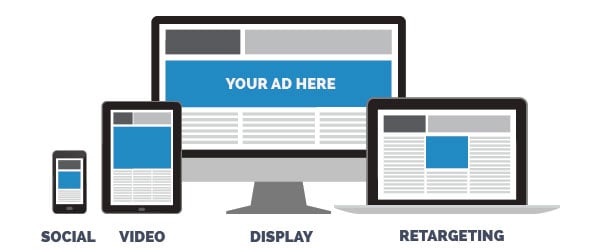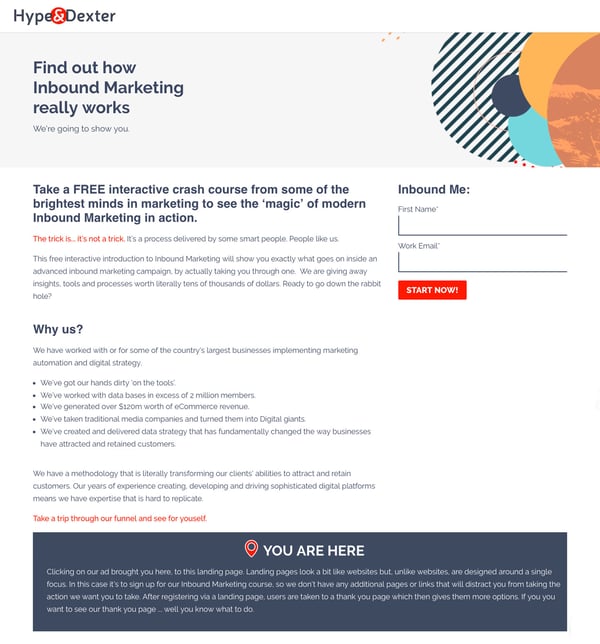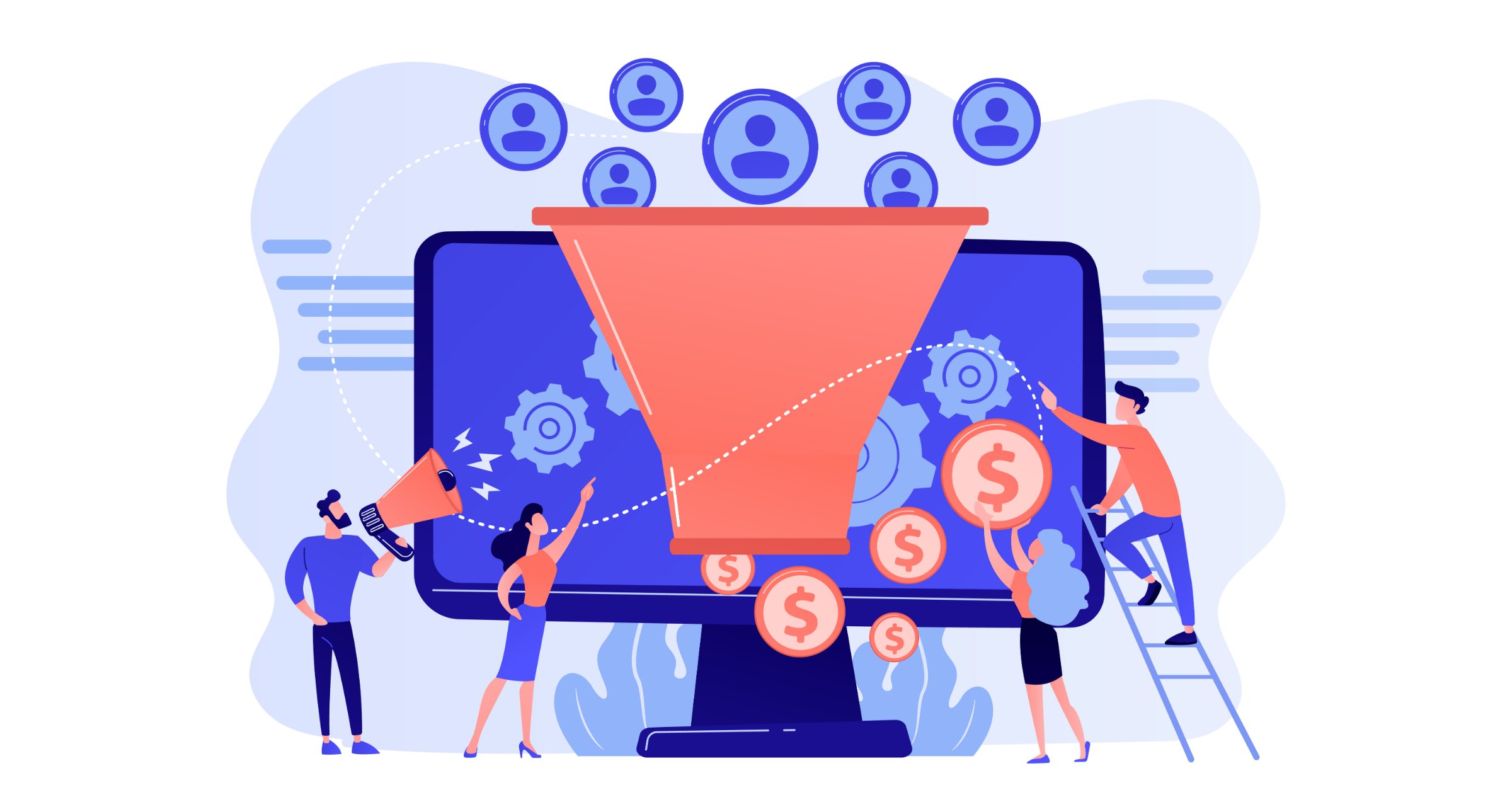In my last post I walked through how to map your customer journey, in this email I will take that customer journey and transform it into a lead generating campaign machine.
Planning your campaign
Every good campaign should start with:
- SMART campaign goals
- A target persona
- Budget
- A customer journey
Also ensure that you understand all of the different assets and channels that you are using as part of the campaign and have mechanisms setup such as tracking URLs so you know exactly where traffic and ultimately leads are coming from.
Target, retarget, convert, nurture & qualify
Ultimately your campaign will:
- Target: In advertising platforms such as search, social and display banners find your target visitors based on existing contacts, keywords, publishers, interests and demographics - push the ads that engage and draw them to your landing page.
- Retarget: Where visitors did not convert or have not engaged for a while, retarget them through advertising platforms with the next best offer/message.
- Convert: Using optimised landing pages, content and social content, convert visitors to leads by getting them to engage with online tools such as forms, chat or messenger.
- Nurture & qualify: Once a lead has engaged, continue the conversation through email, push notifications, messenger and re-targeting to support them through the awareness, consideration and decision stages of their buyer journey. Gather additional details from them by providing additional offers throughout the nurturing process to help to qualify the lead and opportunity.

Get creative
What to say about ‘creative’ when it could be another 10 email series on its own? What I will say straight away is don’t neglect it!
There are lots of doomsayers who reckon creative and creativity doesn’t matter as much anymore in the age of digital marketing – but it absolutely does. Great creative that cuts through a cluttered newsfeed or website and connects with your customers is absolutely key. And when I say ‘connects’ I mean it really connects – makes them stop in their tracks, feel something, and engage.
We all remember great ads from our childhood, and award winning ads from throughout our lives.
And don’t forget that New Zealand has always punched above its weight globally in terms of great ad creative – we are used to seeing great advertising. So yours needs to be pretty good too.
Would you like top five tips for crafting great creative? Great, I've made an infographic that you can download or print, or both! Just click below and it's yours to keep:
Your campaign ads
There are a multitude of advertising channels that can be used to promote your products, services and content. The most common online channels are: Google, Facebook, LinkedIn, YouTube and Display/banner advertising.

The channels and ad formats you should use, and the spend per channel, are very much dependent on your:
- Audience
- Campaign goals
- Product/service you are promoting
- Industry and campaign message/positioning
- Current competition
- Budget
64.6% of people click on Google ads when they are looking to buy an item online.
(WordStream, 2016, source)
Doing it yourself versus outsourcing
Targeting and optimising ads in various channels can be complex, the tools for managing ads are constantly changing as are the channels that you are targeting. What may be fine today, may be a negative factor tomorrow destroying your campaign. Also, it can be very easy to accidentally spend hundreds or even thousands of dollars on the wrong keyword or audience if you are not sure of what you are doing.
In my time at GrabOne we saw one senior and very experienced marketing manager try to do AdWords in house. But he didn’t have time to properly monitor and manage the channel and the result was a negative return on our marketing investment, i.e. the amount it was costing us was more than customers who clicked on the ads actually spent!
A new marketing manager outsourced this function to a company with dedicated digital marketing experts and within 2 weeks this was a profitable marketing channel.
So unless you have a lot of time to spend managing your campaigns, I recommend at least at the beginning using an advertising expert who will keep up with current trends and understand how to set up an optimised campaign to get you the best possible Cost per Click as well as Cost per Lead.
However, there are many dodgy providers peddling advertising services, here are some useful things to check before signing up with a provider:
- Channel autonomy: Will their campaign managers look at all channels, or only focus on a single channel, i.e. Facebook or Google, if the latter they will struggle to provide recommendations on the best channel to spend your dollars. Ask to see the tools that they use.
- Quality leads, not clicks: Although many digital advertising companies will say they focus on generating quality leads in reality very few of them have platforms in place to measure this. Clicks are expensive and if they don’t convert are a waste of money, I have seen countless examples of where advertising companies have recommended spending more on a keyword that has delivered a lot of traffic, which has then been reversed as that traffic was performing far worse than other keywords once you looked at the actual conversion metrics. Ask to see what measurement tools they use to optimise lead generation rather than just traffic.
- The right incentive: Many advertising companies work off a margin of your total ad spend. This is used to pay for ad creation and optimisation, however it naturally causes a conflict with recommending what is actually best for your campaign.
- Over and underspend: Due to the nature of how digital advertising works it can be very difficult to get your spend exactly right and you will regularly see over and underspends month to month. Make sure that you understand how this over/under spend is managed and if you leave the company with a significant underspend what will happen to it.
The 'magic' of retargeting
Have you ever checked out a product or service, and then found that everywhere you go you just keep seeing ads for it? As you are part of our inbound journey you should already have seen this in effect with our ads displaying on various websites and social platforms.
Well, we’re not spending millions of dollars to do this. We are only showing these ads to you, and to anyone who has visited our website or are a contact in our database/CRM.
Retargeting ads are typically much cheaper than other ads as you are showing them to a much smaller direct audience. And they can be personalised to the audiences need, based on the content they have viewed on your site and other engagement.

Social advertising
Of course the other big player in online advertising after Google is Facebook. That incorporates Facebook itself, Instagram (which Facebook owns and serves ads on), and Facebook Messenger (a new channel for advertising but one that will likely see significant growth.)
These are incredible platforms for serving all kinds of ads (image, text, gif, video, slideshow, canvas, and more) and have significant reach.
72% of adult internet users use Facebook.
(Pew Research Center, 2015, source)
And Facebook isn’t just useful for B2C, it can also be used to reach a B2B audience:
74% of people say they use Facebook for professional purposes.
(HubSpot, 2017, source)
The other relevant channel for a business audience is of course LinkedIn. LinkedIn ads tend to be more expensive than Facebook, but you could argue that the audience is more qualified and targeted as you can specify the role, seniority, company size and more of your ideal audience.
25% of adult internet users use LinkedIn.
(Pew Research Center, 2015, source)
Snapchat is an interesting one, with super high engagement and frequency of use, particularly among younger people, and will almost certainly continue to grow as an advertising channel:
Every second, 8,796 photos are shared on Snapchat.
(CEWE Photoworld, 2016, source)
52% of Snapchat users are under the age of 25.
(Statista, 2016, source)
So our strategy, and yours, should be to look at where your audience is first, and focus on that channel (or channels). In most cases, you’re going to start with Facebook – just because of the sheer volume of people already on the platform.
If you want to advertise B2B you should definitely test Facebook vs LinkedIn, and you might be surprised to find that you can reach qualified prospects more cost effectively via Facebook, but that does vary according to industry.
If your product has a strong visual appeal (and beautiful imagery to show it off), you may find Instagram is the channel for you. As the ads are run via Facebook, you’ll have all the same detailed targeting across both channels, so that’s another good one to test.
Which channel works best for an individual campaign really comes down to testing. But being able to engage someone who has experience of all the platforms, who can slice up the budget correctly, and who can look at the right metrics to change things quickly will save you a lot of pain and money.
A word on organic social, algorithms and newsfeeds
You’ll have seen or heard news recently about changes to the Facebook newsfeed, and how the algorithm prioritises content. And you may have seen similar things happening on the other platforms too.
We won’t go into too much detail about it here, but just to say that the business model of these platforms is almost entirely dependant on advertising revenue. Therefore, when it comes to promoting ads and campaigns, very little is likely to change.
Just ensure, for both your paid ads and posts as well as your organic, that your content and activity is of a high quality, is relevant to and adds value for the audience, and gives them a valid reason to interact with you, rather than you trying to game the algorithm for likes and shares!
Whether you are serving a search, display or social ad, the next thing to consider is where the user is going to land when they click. And if you just thought that would be your website, you might want to think again...
Landing pages: your secret weapon in getting users to take action
A landing page is a standalone web page, created specifically for the purposes of a marketing or advertising campaign. It’s different (and more effective for a campaign) than a website because it is designed to make the user take one specific action (one that converts them into a lead).
You can build these yourself as a page of your website (but we wouldn’t recommend this for various reasons). You can look at dedicated solutions such as Instapage or Unbounce (MailChimp now has its own landing page maker as well!) or you could have it all built in your CRM (such as a HubSpot or Marketo). The latter would be our recommendation, as your CRM allows you to collect, track and convert all your leads in one platform. And, as you follow their user journey through, you can layer in things like personalisation, dynamic content, your retargeting, and more.
A great landing page will have:
- A single focus.
- Reflect creative and messaging from your ads.
- No distractions, i.e no navigation or other elements that will take the visitor away from the primary objective on converting
- A great offer, something compelling and highly valuable to the visitor that they will be willing to provide their details to get their hands on it.
- A simple form asking just the right number of questions to meet your marketing objectives without turning off your target personas and losing conversions.
- Credibility, especially important if your a largely unknown brand - promote awards, certificates and other bragging rights to communicate that you are legit.
This is a pretty good example ;)

Advanced landing page tips:
- Use chat to increase conversions for high committal or high value services.
- Use exit intent pop-ups if someone tries to leave without completing the form.
- Hide or prefill any fields that you already know.
- Use progressive profiling to replace hidden/known fields with additional questions to enrich your database.
- Use retargeting to try and re-engage visitors who did not convert.
That’s a long Blog! But it takes us from the campaign planning right through the attract phase and to the convert phase. Next, Romi is going to take you through the part of the funnel that most often gets neglected, and talk about how to monitor and optimise your campaign effectively, as well as how to nurture the leads it generates!
Talk soon,
Alex



Comments